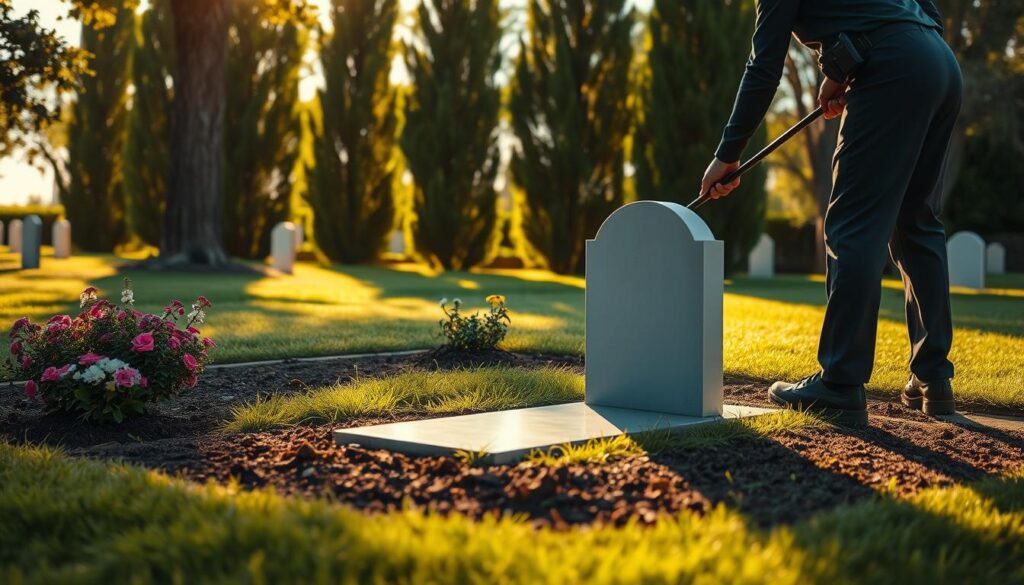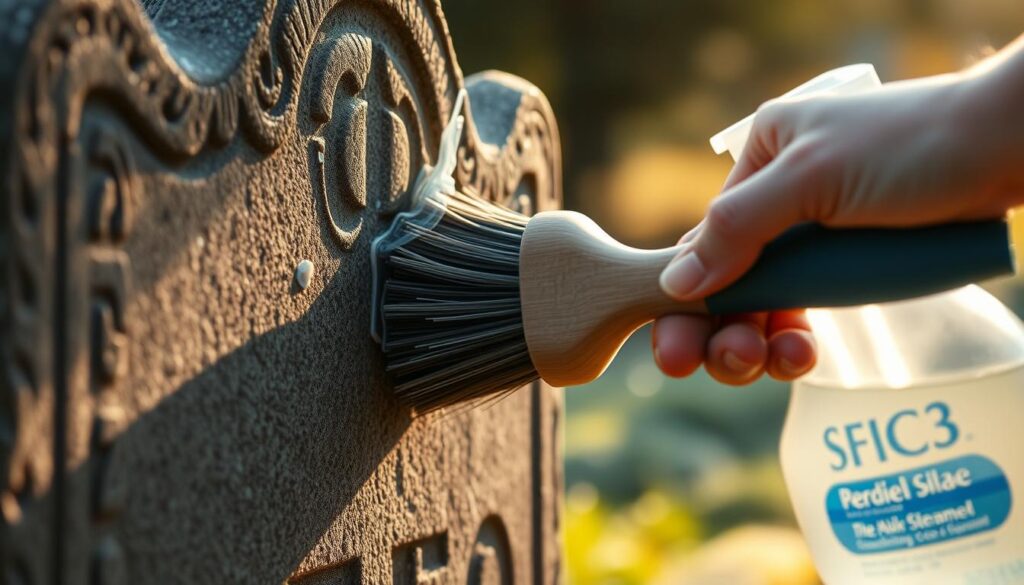Losing a loved one is never easy. Keeping their gravesite in good condition can be tough. Professional gravesite care helps, letting you focus on remembering them instead of upkeep.
When you think about hiring gravesite care, know what to look for. Check their experience, services, and reputation. This way, you can be sure their gravesite is cared for with respect.
Key Takeaways
- Understand the importance of professional gravesite care
- Evaluate the experience of service providers
- Consider the range of services offered
- Research the reputation of gravesite care services
- Make an informed decision when hiring gravesite care
The Significance of Professional Gravesite Maintenance
Professional gravesite maintenance is key to showing respect for your loved one’s final resting place. It shows your love and care for them. It also makes the gravesite a peaceful spot for visitors.

Honoring Your Loved Ones Through Consistent Care
Keeping the gravesite clean is a way to honor your loved ones. Regular upkeep keeps the site looking good all year.
- Cleaning the headstone or monument
- Maintaining the surrounding landscaping
- Placing seasonal flowers or decorations
These actions show you’re committed to remembering and honoring them.
Why DIY Maintenance Often Falls Short
DIY gravesite care might seem like a good idea, but it often doesn’t work out. It lacks the expertise and tools needed. Professional services have the skills and tools to do the job right.
They know how to clean headstones without damaging them. They also follow cemetery rules, making sure everything is done correctly.
What Gravesite Care Services Actually Provide
It’s important to know what gravesite care services offer. They help keep your loved one’s final resting place clean and respected. These services can change, but they usually include basic maintenance and extra options.
Core Maintenance Services Explained
Core services include regular visits to clean the headstone and remove debris. They also make sure the grave is weed-free. Lawn care, like mowing, is also part of these services. Some providers even prepare graves for special days like Memorial Day.
Typical Core Services:
| Service | Description | Frequency |
|---|---|---|
| Headstone Cleaning | Cleaning the headstone to remove dirt and grime | Quarterly |
| Lawn Care | Mowing and edging around the grave | Bi-weekly during growing season |
| Debris Removal | Removing debris and weeds from the gravesite | Monthly |
Additional Services That Add Value
Many services offer more than just basic care. They include floral arrangements and seasonal decorations. Some even arrange special visits or ceremonies.

Knowing what services are available helps you choose the right one. This ensures your loved one’s resting place is cared for as you wish.
5 Things to Know Before Hiring a Gravesite Care Service
Before you choose a gravesite care service, it’s key to know what to look for. Picking a professional service is a big decision. It ensures your loved one’s resting place is kept with respect and care. To choose wisely, consider a few important points.
Understanding the scope of services and the level of care is vital. Also, think about the service provider’s experience and reputation.
Overview of Critical Selection Factors
When picking a gravesite care service, several key factors matter. These include the area they cover, how often they visit, and the services they offer. It’s also important to evaluate their communication practices and how they document their work.
Knowing these factors helps you make a better choice. This ensures your loved one’s gravesite is well taken care of.
Thing 1: Service Coverage and Visit Frequency
When looking at gravesite care services, knowing their coverage and visit frequency is key. The care your loved one’s gravesite gets affects its look and upkeep.
Service coverage is about the tasks and services offered. Visit frequency is how often they do these tasks. Both are important for keeping the gravesite in good shape and showing respect.
Determining the Optimal Visit Schedule
Finding the right visit schedule depends on a few things. These include the cemetery’s rules, the type of grave marker, and what you prefer. Gravesites needing regular upkeep, like flower changes or cleaning, might need more visits.
Weekly vs. Monthly vs. Quarterly Options
Gravesite care services often have different visit options. Weekly visits are best for gravesites needing constant care, like fresh flowers. Monthly visits strike a balance between upkeep and cost. Quarterly visits are good for gravesites needing less care.
Seasonal Considerations for Complete Care
Seasons can change how a gravesite looks. A good care service will consider these changes. For example, they might remove leaves in fall or snow in winter. This keeps the gravesite looking good all year.
Special Occasion and Holiday Services
Many services offer special services for holidays like Christmas or Easter. These add a personal touch and show respect for your loved one.
Thinking about service coverage and visit frequency helps keep your loved one’s gravesite in great shape. It’s important to talk to the service provider about your needs. This way, you can find the best schedule and services for your loved one’s gravesite.
Thing 2: Understanding Pricing Models and Contracts
To avoid unexpected expenses, it’s vital to grasp the different pricing models and contract terms offered by gravesite care services. Gravesite care providers have various pricing structures to fit different needs and budgets.
Common Fee Structures in the Industry
Gravesite care services use several common fee structures. These include per-visit charges, annual contracts, or a mix of both. Knowing these structures helps you manage your expenses well.
Per-Visit vs. Annual Contract Comparison
Per-visit charges depend on how often you visit, based on the service provider and your needs. Annual contracts offer a fixed price for a year’s services, making expenses predictable. Comparing these options helps you find the best value for your situation.
Contract Terms That Protect Your Interests
When reviewing a contract, look for terms that protect you. This includes clear service definitions, payment terms, and options for changing or canceling the contract. Carefully examining these details helps avoid misunderstandings and ensures your needs are met.
Identifying and Avoiding Hidden Costs
Hidden costs can come from extra fees for services like special decorations or emergency visits. To avoid surprises, ask about any extra charges in the contract. Transparency is key for a good service experience.
Understanding pricing models and contract terms helps you make a choice that fits your budget and gravesite care needs.
Thing 3: Verifying Provider Qualifications and Reputation
To make sure your loved one’s gravesite is cared for, check the provider’s qualifications and reputation. It’s important to verify the credentials of the care services. This ensures your loved one’s final resting place is in good hands.
Essential Credentials and Insurance Coverage
A good gravesite care provider should have the right licenses and certifications. They must also have insurance, like liability insurance, to protect against damage or accidents. Make sure their insurance is current and covers their services.
Look for these important credentials:
- Professional certifications from recognized organizations
- Liability insurance for their services
- Compliance with local and national laws
Evaluating Experience and Cemetery Relationships
The provider’s experience matters a lot. Check if they have worked in the cemetery where your loved one is buried. A provider with good relationships with the cemetery can handle rules better and ensure they follow them.
| Experience Factor | Importance | What to Look For |
|---|---|---|
| Years of Service | High | More experienced providers are often more reliable |
| Cemetery Relationships | High | Good relationships with the cemetery make service smoother |
| Staff Training | Medium | Well-trained staff can provide better care and solve problems |
Effective Methods for Checking References
Checking references is key to verifying a provider’s reputation. You can ask for references or look at online reviews on Google or Yelp. Look at the overall rating and what people say in reviews.
Thing 4: Communication Standards and Documentation Practices
Clear communication and detailed documentation are key for a reliable gravesite care service. They give families peace of mind. When a service is open and talks clearly, families know their loved one’s memorial is cared for right.
Setting Clear Expectations for Service Updates
It’s important to know how and when you’ll hear from the gravesite care service. This means understanding their communication methods, like email, phone, or online portals. Knowing how often they’ll contact you helps you stay informed and quickly solve any problems.
Photo Documentation and Reporting Systems
Many services now include photo documentation in their reports. This visual proof shows the service was done as agreed, adding to your peace of mind. When looking at services, ask about their photo policies and reporting systems.
Response Time Guarantees and Emergency Protocols
A good gravesite care service has clear response times and emergency plans. This means any problems or concerns are handled fast and well. Knowing these plans helps you feel confident in your choice.
Digital vs. Traditional Communication Options
You might prefer digital updates like emails or online reports, or traditional methods like phone calls or mail. A flexible service will meet your communication needs. This ensures you get updates in a way that suits you best.
| Communication Method | Advantages | Disadvantages |
|---|---|---|
| Email Updates | Provides a paper trail, convenient for record-keeping | May be overlooked in a crowded inbox |
| Phone Calls | Personal touch, allows for immediate questions | May be intrusive, requires immediate attention |
| Online Portals | Centralized information, accessible at any time | Requires internet access, may have a learning curve |
Thing 5: Customization Options for Personalized Remembrance
Customization options can greatly honor your loved ones. Gravesite care services offer many ways to personalize their services. This ensures a remembrance that truly reflects your loved one’s life.
Floral Arrangement Services and Schedules
Floral arrangements are a keyway to personalize gravesite care. Providers offer customized arrangements. You can choose the flowers and schedule for delivery.
- Seasonal flowers to match the time of year
- Specific flower types chosen for their personal significance
- Regular delivery and arrangement to maintain a consistent tribute
Seasonal Decoration and Memorial Tributes
Gravesite care services also offer seasonal decorations and memorial tributes. These include:
- Holiday-specific decorations, such as Christmas wreaths or Easter flowers
- Personalized memorial items, like engraved vases or plaques
- Seasonal candles or other decorative elements
Accommodating Cultural and Religious Requirements
Services also meet cultural and religious needs. This includes:
-
- Specific rituals or practices being performed at the gravesite
- Cultural or religious decorations being placed on the gravesite
- Coordination with family members or religious leaders to ensure respectful care
Personalization Options Beyond Standard Care
Some providers offer unique personalization options. These include:
-
-
- Customized grave blankets or covers
- Special occasion tributes, such as anniversary or birthday flowers
- Coordination with local artists or craftsmen for unique memorial pieces
-
Choosing a gravesite care service with customization options allows for a personalized tribute. This honors your loved one in a special way.
Essential Questions to Ask Service Providers
Looking for a gravesite care service? It’s key to ask the right questions. This ensures you find a provider that fits your needs. Asking about their services and business practices helps you make a choice that respects your loved one.
Service Scope and Quality Assurance Questions
First, ask about the services they offer. This includes grave cleaning, flower arrangement, and seasonal decoration. Also, find out how they ensure quality in their work.
Some good questions are: “What’s in your standard package?” and “How do you keep your staff’s work up to par?”
Business Practices and Accountability Questions
It’s also important to ask about their business practices. You’ll want to know about insurance coverage, licensing, and bonding. This protects you from any risks.
Ask about their communication too. How do they handle your questions and concerns? For example, “What insurance do you have?” and “How do you deal with customer complaints?”
Navigating Cemetery Regulations and Restrictions
Gravesite care services face many rules to provide the best care. Each cemetery has its own set of rules. These rules affect the maintenance and services allowed.
Cemetery-Specific Rules
It’s important to know the specific rules of a cemetery. These rules cover everything from flowers to visits by care services.
Key areas regulated by cemeteries include:
- Decoration policies
- Floral arrangement guidelines
- Memorial or monument specifications
- Visitation and maintenance schedules
Facilitating Provider-Cemetery Communication
Good gravesite care services talk well with cemetery authorities. They get permits, plan visits, and follow decoration rules.
| Cemetery Regulation Aspect | Importance for Gravesite Care | Typical Requirements |
|---|---|---|
| Decoration Policies | High | Specific rules on types of flowers, vases, and other decorations |
| Visitation Schedules | Medium | Regulated visitation times for maintenance and memorial services |
| Memorial Specifications | High | Guidelines on the size, material, and design of headstones and memorials |
Following cemetery rules helps keep your loved one’s gravesite respected and cared for.
Monitoring and Evaluating Service Quality
To keep your loved one’s gravesite in good condition, it’s important to check the service quality. This ensures their memorial is treated with respect and care. Regular checks help spot any areas that need better service.
Consistent monitoring lets you fix problems fast. This keeps the gravesite looking its best. You’ll know if the provider is following the agreed-upon services and doing a good job.
Creating Your Personal Quality Assessment Checklist
Making a checklist to evaluate your gravesite care provider is a smart move. It should cover important points like:
- Timeliness and frequency of visits
- Condition of the gravesite after each visit
- Responsiveness to special requests
- Communication effectiveness
With a clear checklist, you can easily see how well the provider is doing. You can also find areas that need better service.
Addressing Service Shortfalls Effectively
If you find any service problems, it’s important to talk about them. Start by writing down the issues and then talk to the provider. A respectful conversation can often fix problems quickly.
For example, you can use a table to track and solve service problems:
| Issue | Date Notified | Resolution | Date Resolved |
|---|---|---|---|
| Poor grave cleaning | 2025-03-01 | Re-cleaning and additional staff training | 2025-03-05 |
| Delayed response to query | 2025-04-10 | Improved communication protocols | 2025-04-15 |
“The way we care for our loved ones’ gravesites reflects our respect for their memory.”
Good communication and a methodical way to solve problems are key to keeping service quality high.
Conclusion: Making an Informed Decision for Your Loved One’s Memorial
When choosing a gravesite care service, think about what’s best for your loved one’s memorial. Knowing the importance of professional care, the services offered, and what to look for in a provider helps. This way, you can make a choice that respects their memory.
You’ve learned about key things like service coverage, pricing, and the provider’s qualifications. Also, communication and customization are important. By looking at these, you can find a service that fits your needs and gives you peace of mind. Good gravesite care keeps the memorial dignified, and the right provider will honor your loved one’s memory.
With the knowledge from this article, you’re ready to choose the best gravesite care. Your loved one’s memory is worth the best care. With the right service, their memorial will remain a special tribute.
FAQ
What services are typically included in a gravesite care package?
Gravesite care services include lawn mowing and decorating the grave. They also arrange flowers and add seasonal tributes. This keeps your loved one’s memorial looking great.
How often should I expect a gravesite care service to visit the cemetery?
Visit frequency varies based on your chosen package. You can get visits from weekly to quarterly. It’s all about what your loved one’s gravesite needs.
Can gravesite care services accommodate special requests or cultural practices?
Yes, many services offer custom options. They can handle unique floral arrangements and seasonal decorations. This way, they meet your cultural or personal preferences.
How do I verify the qualifications and reputation of a gravesite care provider?
Check their credentials and insurance. Look at customer reviews and their experience. Also, see how well they work with local cemeteries.
What kind of communication can I expect from a gravesite care service?
Good services keep you updated with regular reports and photos. They make sure you know what’s happening with your loved one’s gravesite.
Are there any additional costs or fees associated with gravesite care services?
To avoid surprises, know the pricing and contract terms. Look out for any hidden costs or fees.




